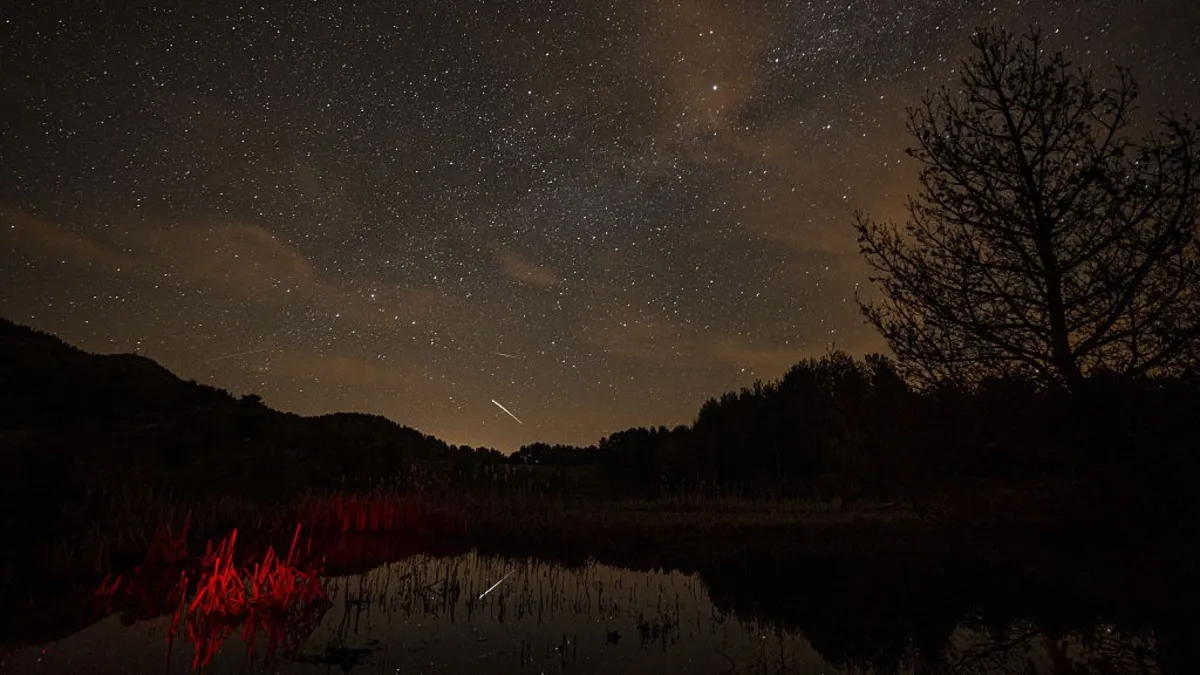
The Lyrid meteor shower recently captivated sky watchers with a breathtaking performance, showcasing a peak rate of 10 to 20 meteors each hour. This annual celestial event occurs between April 16 and April 25, as Earth traverses through a trail of primordial debris left by the ancient comet C/1861 G1 Thatcher. This particular comet takes approximately 415 years to complete its long, looping orbit around the sun, making the Lyrid meteor shower a fascinating occurrence for astronomy enthusiasts.
The Lyrids boast an impressive history, with the first recorded observations made by Chinese astronomers as far back as 687 BC. This makes the Lyrid meteor shower the oldest recorded recurring meteor shower that is still active today, according to data from NASA. Skywatching photographers from around the globe eagerly awaited the chance to capture the stunning display of the 2025 Lyrids, particularly as Earth moved through the densest portions of Thatcher's debris trail.
Fortunately for stargazers, the moon remained below the horizon during much of the meteor shower, allowing for an unobstructed view of the night sky. As we delve into the remarkable images captured during the Lyrid meteor shower 2025, let's highlight some of the most spectacular photographs taken by talented astrophotographers.
One remarkable image was taken by astrophotographer Utku Ucrak, showcasing a series of brilliant meteors streaking across the night sky over the Karagol Geosite in the Kizilcahamam district of Ankara, Turkey, on April 22. The meteors were beautifully framed by a dark treescape, illustrating the awe-inspiring spectacle of the Lyrids.
Another impressive shot was captured by photographer Muhammed Selim Korkutata, who documented a mesmerizing Lyrid meteor streaking through the sky, reflected in a body of water below. This striking image was also taken on April 22, from Mount Isik in the same Turkish district.
Meanwhile, night sky photographer Sebastian Voltmer artistically showcased a Lyrid 'shooting star' against the stunning backdrop of the Milky Way from his home village in Germany, capturing the ethereal beauty of the meteor shower.
The residents of Brisbane, Australia, were treated to an extraordinary sight on April 21 when a vivid fireball illuminated the evening sky. Fireballs are exceptionally bright meteors that can rival the brightness of Venus. According to NASA, these larger meteors often do not survive their fiery descent through the atmosphere, although fragments may occasionally be found on the ground after experiencing the intense heat of atmospheric re-entry.
There is some debate regarding the origin of the April 21 fireball, with discussions about whether it belonged to comet Thatcher, like the other Lyrid meteors, or if it was a random meteor that fortuitously appeared near the Lyrid peak. Jonti Horner, an astronomer from the University of Queensland, clarified in an interview that the fireball was not part of the Lyrid meteor shower, as it occurred too early in the evening.
Not all sightings were fireballs; many amateur astronomers shared their experiences online. Minnesota-based X user EricTheCat posted an impressive compilation of Lyrid meteor streaks taken on April 20, as the shower geared up for its annual peak. Another user, Rodamort, utilized a GoPro camera to capture stunning star trails alongside occasional Lyrid meteors from Northern Idaho. "Wasn't great last night, but caught a few meteors crossing the sky in the Lyrid meteor shower," Rodamort noted in a post on X.
If you missed the initial display, there's still time to catch the Lyrids, which will remain active until April 25. It’s not too late to venture out after dark and capture your own images of this spectacular meteor shower. For the best experience, be sure to dress warmly and find a location away from city lights.
The Lyrid meteors originate from the constellation Lyra, particularly near the bright star Vega in the northeastern sky. Using a planetarium app like Starry Night or Stellarium, you can pinpoint Vega and look for a patch of sky about 40 degrees away from it towards your local zenith—the point directly overhead. A helpful tip for gauging distance in the night sky is to hold your arm out straight in front of you; the span from your thumb to the opposite side of your fist measures roughly 10 degrees. By stacking four outstretched fists above Vega, you'll locate the ideal area for meteor hunting!
If you've captured stunning images of the Lyrid meteor shower, we would love to see them! Share your photos, comments, and your name and location with us at spacephotos@space.com. Your photography could inspire fellow astronomy enthusiasts!